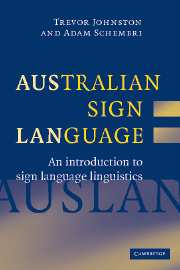Book contents
- Frontmatter
- Contents
- Acknowledgements
- Conventions for sign notation
- 1 Signed languages and linguistics
- 2 Auslan in social context
- 3 Auslan and other signed languages
- 4 Phonetics and phonology: the building blocks of signs
- 5 Morphology: sign formation and modification
- 6 Lexicon: the structure of Auslan vocabulary
- 7 Syntax: the structure of sentences in Auslan
- 8 Semantics and pragmatics: sign meaning and sentence meaning
- 9 Discourse: structure and use above the sentence
- 10 Issues in the study of signed languages
- References
- Index
7 - Syntax: the structure of sentences in Auslan
Published online by Cambridge University Press: 02 December 2009
- Frontmatter
- Contents
- Acknowledgements
- Conventions for sign notation
- 1 Signed languages and linguistics
- 2 Auslan in social context
- 3 Auslan and other signed languages
- 4 Phonetics and phonology: the building blocks of signs
- 5 Morphology: sign formation and modification
- 6 Lexicon: the structure of Auslan vocabulary
- 7 Syntax: the structure of sentences in Auslan
- 8 Semantics and pragmatics: sign meaning and sentence meaning
- 9 Discourse: structure and use above the sentence
- 10 Issues in the study of signed languages
- References
- Index
Summary
The previous chapter examined the structure of the lexicon of Auslan. In this chapter, we discuss the syntax of Auslan. Syntax refers to the rules or conventions in a language that relate to the correct or acceptable ordering of words in a sentence. In English, for example, there is a syntactic rule that requires words such as a or the to precede a noun like man or woman in order to create phrases such as the man or a woman. Combinations such as man the are not acceptable phrase structures in English. Similarly, in Auslan, there conventionally accepted sign orders which we discuss below.
In contrast to descriptions of English syntax, however, the discussion of Auslan syntax in this chapter is very brief. There is also relatively more available information on the syntax of other signed languages, particularly ASL. Much of this research on ASL sentence structure, however, has been based on studies that elicit judgements about the acceptability of particular sentence structures from native signers (e.g., Neidle et al., 2000; Sandler & Lillo-Martin, 2006). Recall from Chapter 2 that most signers, including native signers, live and communicate in a complex language contact situation. This makes acceptability judgements difficult to evaluate and researchers therefore need to take actual usage into account. However, research into usage requires a large amount of data (i.e., a corpus) to be collected, coded and analysed. Due to recent advancements in digital video and annotation technology (see Chapter 10), work of this kind has only recently begun in Australia (Johnston & Schembri, 2006), and thus a comprehensive account of Auslan syntax will only emerge in the future.
- Type
- Chapter
- Information
- Australian Sign Language (Auslan)An introduction to sign language linguistics, pp. 189 - 218Publisher: Cambridge University PressPrint publication year: 2007



